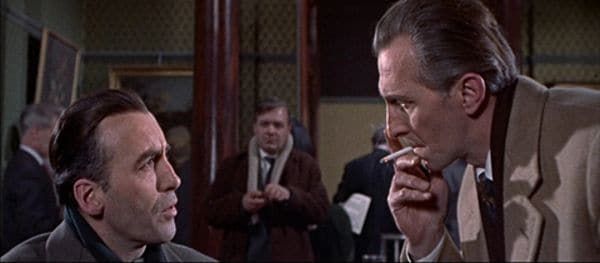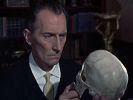Eye For Film >> Movies >> The Skull (1965) Film Review

In terms of horror pedigree, few films outclass The Skull, which makes it curious that it's so little known. The combined talents of Peter Cushing and Christopher Lee ought to attract more attention, there's an dramatic soundtrack by avant garde composer Elisabeth Lutyens and the plot was adapted from a short story by Robert Bloch. The whole thing looks stunning, thanks in large part to sumptuous set decoration by Scott Slimon, especially where a host of exotic treasures crowds the central character's home.
Christopher Maitland (Cushing) is a collector. He has the same kind of obscure mementos of empire that wash up in many an aristocrat's home, but he's particularly interested in occult items; though his resources are limited and he can't always outbid friendly rival Sir Matthew Phillips (Lee), he has various shady means of getting hold of things that don't even make it to the auctions. After losing out on a lot of four sinister statues to Lee, he's approached at home by unscrupulous dealer Marco (Patrick Wymark) who has something more interesting to sell: an original book, bound in human skin, containing the writings of the Marquis de Sade. There's more. There is a skull. It was dug, Marco claims, from the Marquis' grave. Could it be possessed by an evil spirit? Maitland isn't convinced, but he does become obsessed; he wants to possess it, at any cost.

The sinister stories surrounding the Marquis are so well established as lore that they don't need to be recounted or explained here. Their power lies simply in the dead man's mystique, a supreme irony given how he sniped at such authority in his lifetime. Maitland also possesses a dagger supposed to have belonged to Gilles de Rais; in this way, the film builds a historical and literary niche for itself which could be seen as pretentious in the extreme but which is carried by the excellent cast. Lee is in noble hero mode here and could be an early version of his character in The Devil Rides Out. Wymark is superbly sleazy whilst keeping his character's keen intelligence to the fore. It's Cushing's film, however, and he carries the final 15 minutes with barely a word being spoken.
There is another major character in the film, and that's the skull itself. We see it smashing out of a cabinet, floating down corridors; and we see through its eyes. This may look cheesy on one level (rather wonderfully so), but it also gives the film a surreal aspect that can be quite disturbing. By placing the viewer inside the skull, director Francis challenges us to consider why we started watching - don't we want to see terror and bloody death? In this way we are invited to recognise that the Marquis' desires may not have been that unusual after all.
Again ironically, in view of the Marquis' concerns, this film was heavily shaped by the censor, cutting out the erotic aspects and some of its gorier ideas, but it retains a more brutal edge than many contemporary productions. In form it's a classic tragedy, the consequence of Maitland's fascination all too visible from the start, but it's no less gripping for that. It's a must-see for Cushing fans and an intriguing curiosity for horror fans more generally.
Reviewed on: 21 Oct 2015

















